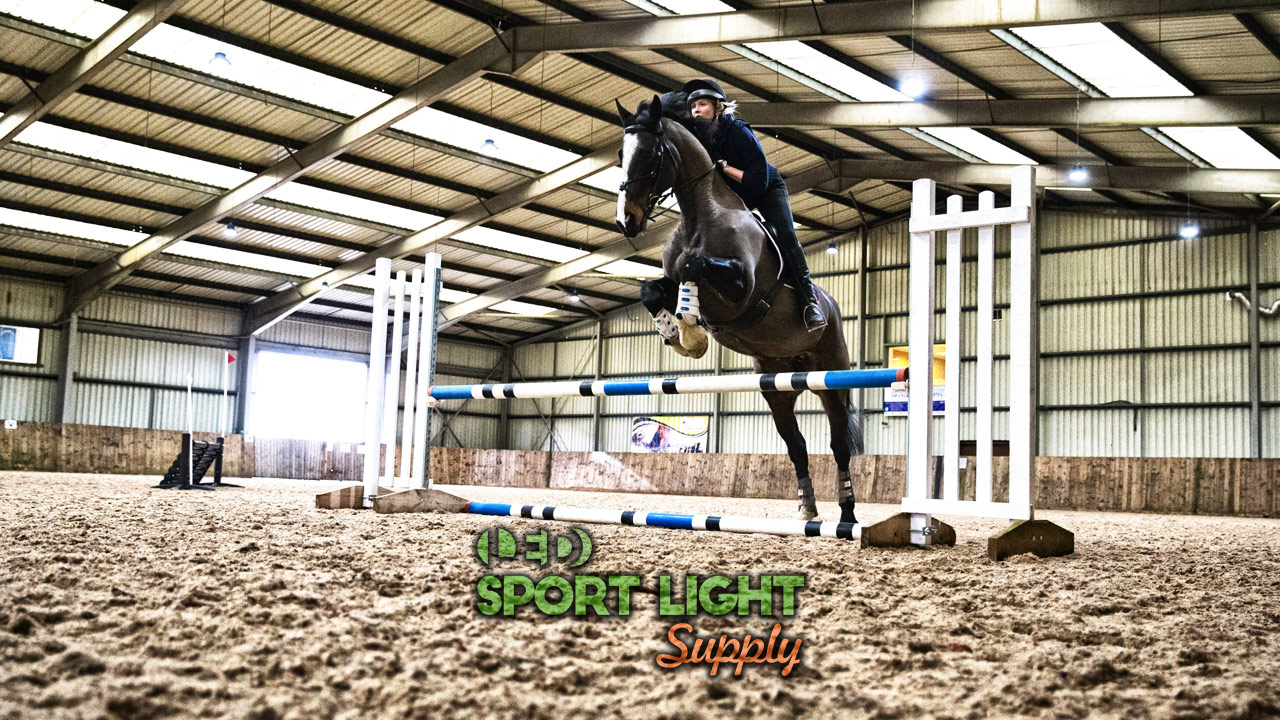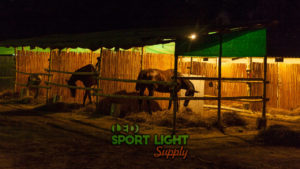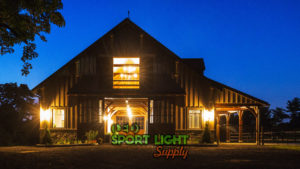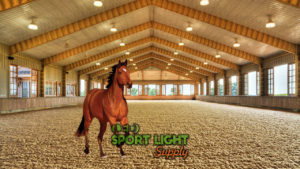What lights are used in the equine arena?
1. Flood lights for outdoor horse arena
Here are the large beam angles that you’ll want to use for close range lights. These can include 200W, 400W, 1000W, 1500W as the common wattages of horse arena floodlight. Close range lights are best for watching horse movement that can be studied by the equine judges. This will also give viewing attendees the best view of how a horse is performing under these arena lights.
Being able to spot selective commands and obedience of the competing horse will also have an impact on their scoring. Outdoor lighting levels for wattage will all depend on the size of the arena too.
2. Spotlights
For especially tall lights on might masts, the usage of the small beam angle for long-range is recommended. This unobtrusive form of outdoor lighting improves the overall light coverage that is seen within the horse arena. When horses aren’t performing, these lights can be less intrusive and give plenty of surface area illumination for practice regularity. Because of the height of these lights, equine trainers can study muscle movement and elasticity to bring-out the best horse skills.
It’s not uncommon that training sessions will be necessary at night to allow competing horses to adjust to night time competitions.
3. Solar lights
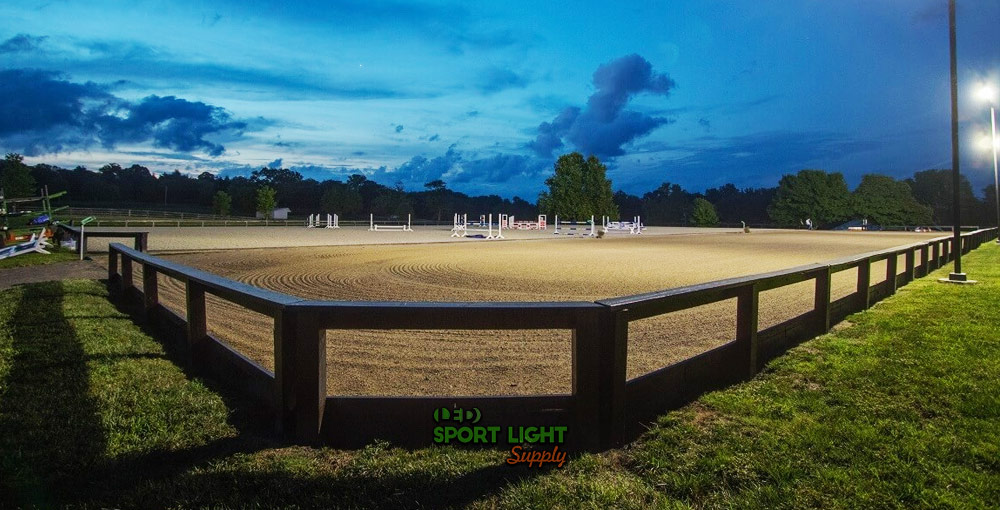
Some owners will love the option of using solar light packages for their outdoor arena. This is mainly for hassle-free installation when it comes to setting up the lights. It also helps greatly at reducing electricity costs at night. These light systems can gather sunlight during the day using solar panels. The electricity that’s collected can be used to light the arena at night for several hours.
Because of the potential dust that is kicked up in the arena from horse hooves, the solar panels do need to be cleaned often. This will keep dust and dirt from preventing the solar panel from collecting energy.
4. High mast lights
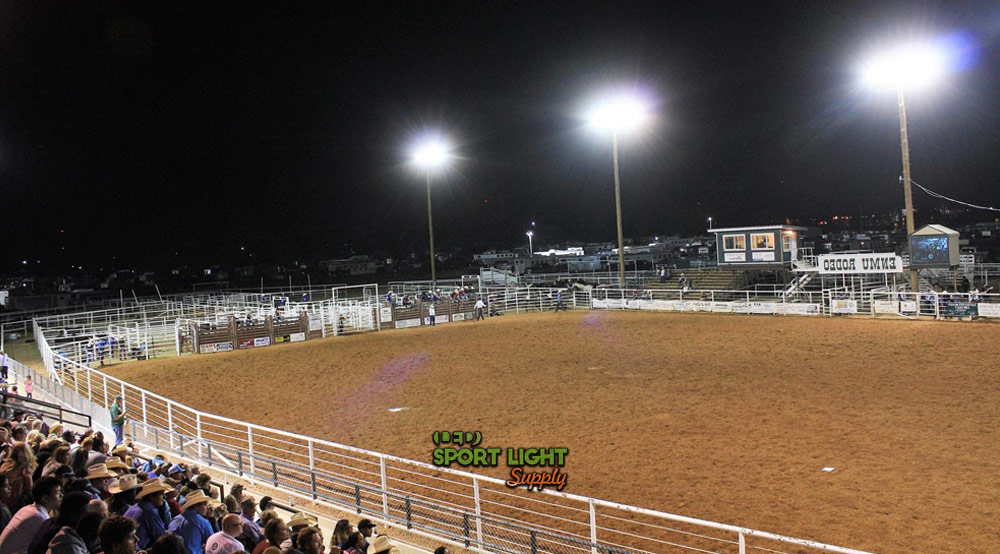
Just in case you need to know how tall high mast lights need to depend on your outdoor arena. This can range from 6-18 meters tall and each light pole is placed at the corners outside the arena. Because of the height difference, the stronger the light fixture needs to be. This is because of the distance from the arena and possible light loss that can occur. High mast lights will be good for larger performance arenas where large crowds will gather.
The light fixtures used for high masts will need the proper amount of wattage to adjust for the height and distance involved.
5. High bay lights for an indoor riding arena
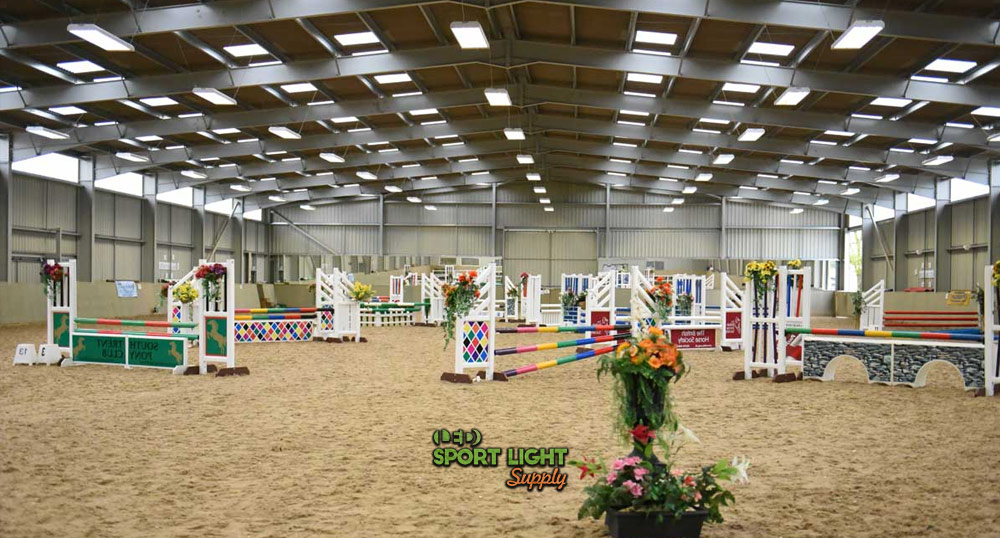
Indoor arenas that are built inside a standing structure will require high bay lights to illuminate the horse arena. These lights are hung from the ceiling and pointed downward. Depending on the height of the ceiling, the beam angle needs to be determined to get the most out of light coverage. There can also be specific size panels that are installed to compensate for the size of the building.
These lights are set-up in a grid that will be based on the shape of the building. This will give better light uniformity over the surfaces you need to illuminate.
Goals of horse arena lighting
1. Bright lighting for equestrians
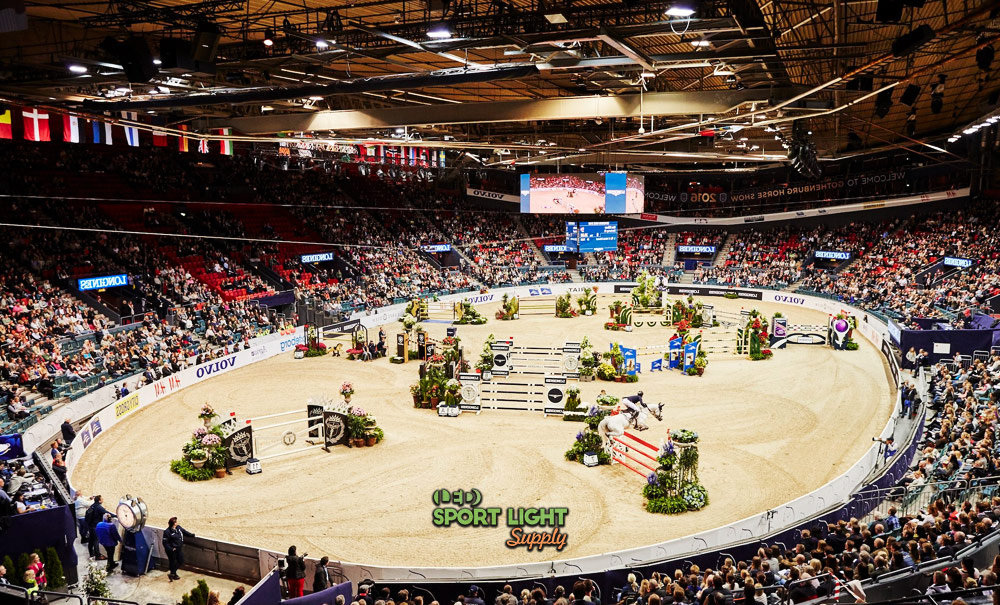
Especially for the purpose of performance and competition, equestrian riding skills are best showed-off with bright lighting. Not so bright that it becomes blinding but to feature the special skills that horses have learned. This also includes the quality, purity, and obedience of a horse that has desirable show skills. When all of these attributes are clearly seen with the correct amount of show lighting, it’s better judged for their form.
It will be more typical that brighter lights are used for official events and competitions. This higher degree of lighting is also better for photographers and TV cameras covering these events.
2. For the horses’ health
Horses react to certain types of light more than others, so there’s a limit to the type of light they need for performing. There is also the need to regulate the amount of lighting that is best for horses while performing. Horses are not overly sensitive to sunlight conditions and will see at their best at this light level. Even for equestrian performances, higher levels will help them navigate the arena as they were trained.
Lower light levels aren’t especially bad for horses but there are specific recommended levels that apply to everyday training and professional lighting conditions.
3. Security
As far as security goes, you can never be safe enough when there are valuable horses around. For security, you need bright lights that will detour predators or animals that you don’t want prowling around. The same can also apply to would-be thieves who are looking for things to steal. Motion sensor lights on high poles are an excellent deterrent that works for your security.
These lights come on instantly as soon as there is the motion that’s sensed and can be set on a timer. These lights can also be placed in areas where the entrances to stables and barns are critical.
Outdoor horse arena lighting layout
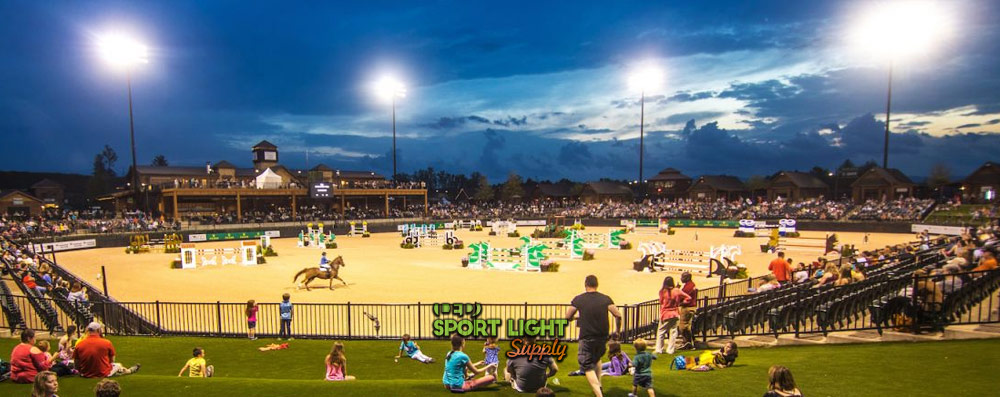
1. Number of poles
For the outdoor arena, you will need at least 4-6 poles depending on the riding arena size. Depending on the height of each pole will also have to have smaller beam angles so the light can disperse. The further away the poles are to the arena also will need to calculate the amount of potential light loss. Then the wattage is finally adjusted for the height and the distance involved.
All of the factors together will allow the horse arena to be lit correctly without losing light uniformity. Even after that, small adjustments must be made for light pollution and glare issues. Aside from side lighting, lights mounted on poles need to be planned beforehand.
2. Light pole height
There will be a significant amount of height range when it comes to the total height needed for pole lights. This can range from 6-18 meters depending on the budget involved. The taller the light pole that you order, the better the light uniformity tends to be. But this will also depend on the beam angles and how the height and fixture wattage are calculated. There is a formula that we can assist with that will calculate these requirements.
The taller the pole happens to be, the higher the beam angle will be narrowed. This is so the amount of light that travels from a further distance will spread uniformly.
3. Side lighting Vs corner lighting
There is nothing wrong with side lighting as this is light that’s added to improve arena visuals. It also helps to reduce shadows that are seen with corner lighting. For professional equestrian events, the appearance of horse shadows can be lessened and will look better for competition. Light poles can be placed along the sideline or at the corners of the arena while smaller fill-in side lights finish-off the job.
Sidelights will be helpful for trainers and those who are watching the movement of a horse. As all horse arena events showcase the skills of both the rider and horse, the professional-looking lighting will give a further polished look.
4. Distance between the light pole and sidelines
Just so there is an adequate amount of space between light poles, each light will need to reserve 1-3 meters of spacing. It’s recommended that this spacing allows light to disperse according to a light configuration. This way, a horse arena doesn’t appear cluttered with lighting that’s been installed improperly. There will be more spots on the ground that would be brighter or weaker due to poor configuration.
You want to follow the guide for light conformity as close as possible to get the best lighting arrangement possible. Lights on the sidelines must follow a similar spacing likewise.
Indoor horse arena lighting layout
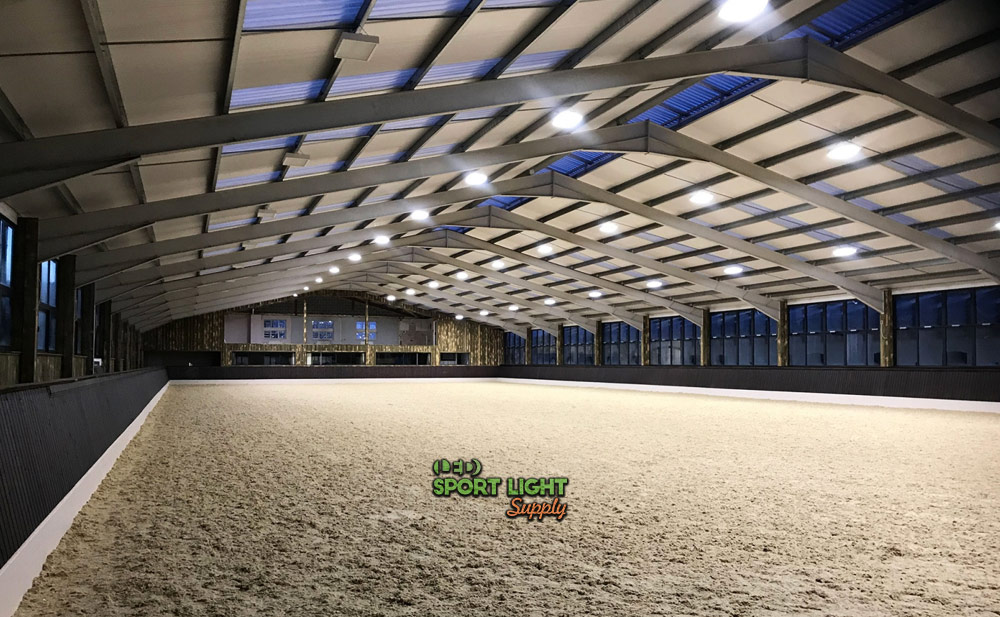
1. Number of high bay lights
High bay lights should be configured into a spacing group. These are groups of lights that can include 5×5, 7×5, or 8×6 spacing. This is simple to figure out as there can be 5 lamps spaced within a line of 5. The total number of lamps used is 25 fixtures in all. Depending on the shape and size of the riding arena, these configurations will be larger and the number of rows of lights will increase as well.
The ceiling height and size of the facility will further determine what beam angle is used. This further ensures the correct amount of light uniformity.
2. Distance between the ceiling floodlights
Each floodlight is required to have 2.5 to 4 meters of space in between each fixture to improve lighting uniformity. In addition to this, they will form a configuration within a set grid pattern. This formula is essentially a group formation that lights up a specific area on the horse arena. With each light properly spaced, the ground below will have better illumination on overlapped areas.
The spacing also depends on the height of the roof so a taller ceiling will have larger spacing. Lower ceilings will obviously have shorter spacing to accommodate the height difference.
3. Ceiling height
Each building will have variations in height depending on where the horse arena is situated. Smaller venues may have a roof height of 5 meters, whereas bigger venues will be as high as 10 meters. This will play a large role in choosing the right kind of light angle because of the height differences. Lower ceilings need to have a wide beam angle since the light spreads out evenly.
High ceilings require narrow beam angles to control where the light beam is spreading. If the wrong beam angle is used on high ceilings, this will have too much light bleed and light pollution outside the illuminated area.
4. Type of ceiling
a) Flat ceiling
A flat ceiling is perhaps the easiest way to mount a light fixture inside a building. The bracket is attached to support beams that span across the ceiling. These may be metal supports or wooden beams as determined by the structure itself. Flat ceilings are less troublesome than other types of ceilings since the lights are pointed downward. Based on how a horse arena is configured, a lighting grid is a set-up to illuminate the ground below.
Lights used for flat ceilings can be efficient UFO-shaped downlights or half dome fixtures. Each fixture has a selected beam angle to control the amount of light coverage.
b) Vaulted ceiling
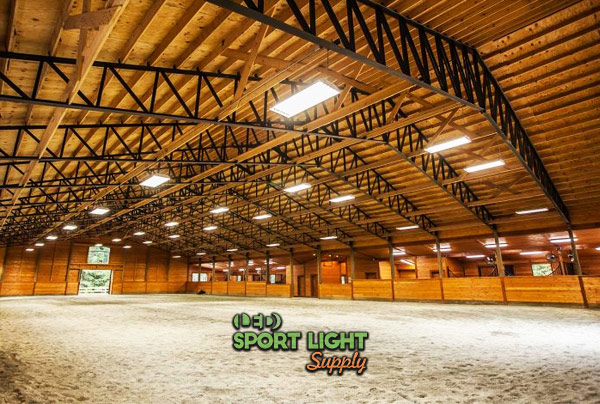 A vaulted ceiling will need a little bit more care when hanging any kind of light fixture. Ceilings with vaulted angles need special brackets so the floodlights are always pointing downward. The bracket will allow for the angle to be adjusted so the beam is pointed directly down to the ground. No matter how steep the angle happens to be, the bracket can accommodate a swivel bracket that can be tightened.
A vaulted ceiling will need a little bit more care when hanging any kind of light fixture. Ceilings with vaulted angles need special brackets so the floodlights are always pointing downward. The bracket will allow for the angle to be adjusted so the beam is pointed directly down to the ground. No matter how steep the angle happens to be, the bracket can accommodate a swivel bracket that can be tightened.
The same kinds of brackets are also just as handy when it comes to side lighting too. Then the lights can be pointed to the exact spot where light fill can be incorporated.
Outdoor and Indoor horse arena lighting design and standards
1. Lux and brightness requirement for horse arena
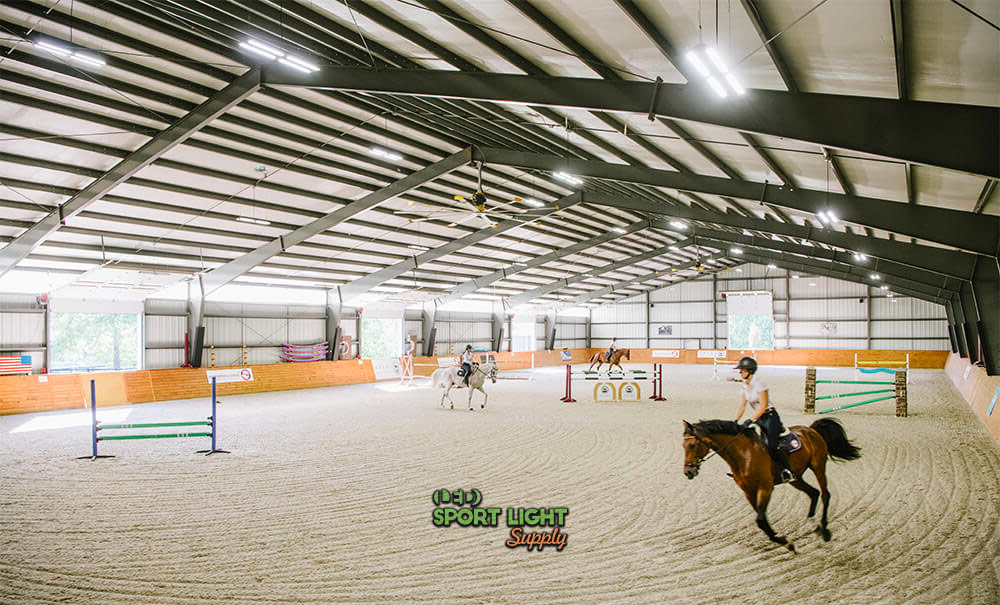
There are specific Lux levels that are significant to the horse arena. They all have merit depending on the amount of light that’s allowed. For recreational and training arenas, it’s more common to see 100-200 Lux giving trainers enough light to work within. This can apply to indoor or outdoor light fixtures. At club levels, the Lux level is increased from 200-300 Lux for regional horse exhibitions and equestrian events.
The national requirement for professional equine events is increased to 500 Lux for spectators and high lighting standards. This can also be meant for professional competitions meant for television broadcasting purposes.
2. Lighting uniformity
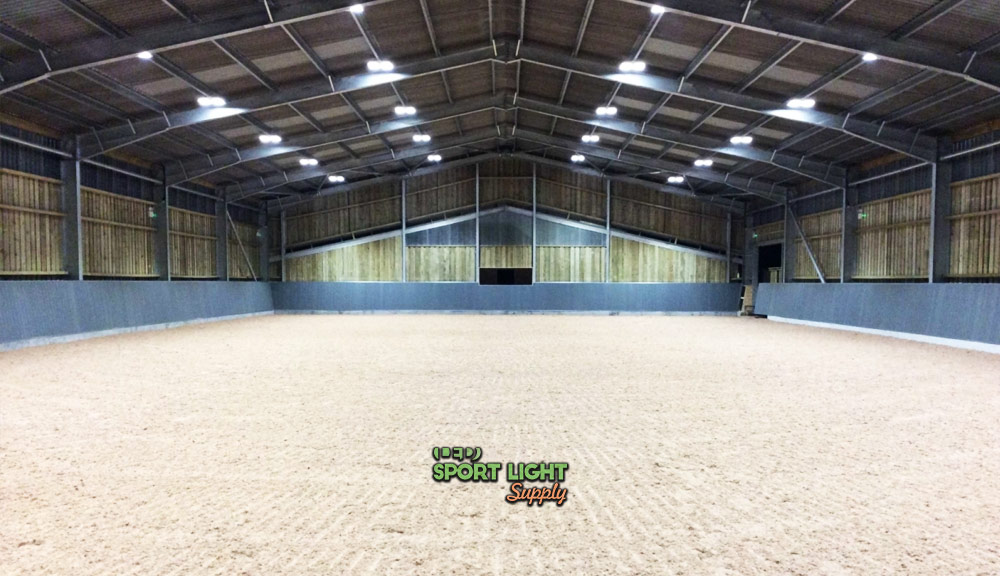
These are the recorded light measurements that ensure the best lighting uniformity strictly for competitive equestrian events. For a professional horse arena, you will see a uniformity level of 0.5 to 0.7. Because of the high lighting uniformity, this can reduce eye strain and fatigue of the equestrian and the horses’ eyes. The light levels will be more comfortable for spectators as well.
Lighting uniformity directly involves Lux levels and indirectly both the level of Lux and Light uniformity go hand in hand. Both of them allow for better light levels that are for the comfort of vision and light coverage.
3. Beam angle
Here is the beam angle that is used outdoors. This is 10 or 25 degrees for long-range, and 40, 60, or 90 degrees for short-range. The reason that a beam angle is narrowed is so the light beam has time to expand due to the distance involved. With indoor lighting, the height of the roof is going to be very similar using 60 to 90 degrees for indoor high bay lights. This is because the ceiling height isn’t going to be so distant, so the beam angle needs to be wider.
Without using the proper beam angle, the light spill will be more problematic and lead to light pollution.
4. Glare rating
Having excess glare coming from lights that are intended for equestrian shows are going to be uncomfortable to be around. This is also dangerous for horses, as their vision is important for their performance. A wrong misstep due to glare will affect the outcome of the purity and quality judging of a competing horse. This can also affect equine riders who may be temporarily blinded by light leaks.
As lights are measured for glare rating, the issues need to be balanced so the light is seen normally. This should be set between the level of uncomfortable and not noticed on a scale of 1 through 9.
5. Color rendering index
This is known as the CRI and measures the amount of light that gives a corrected level for how light is seen by others. In a way, this light is best described as the contrast in which objects are illuminated. Too much CRI will begin to be overexposed and make colors appear unnatural. Too little CRI and the images will appear underexposed and dim. With a correct color rendering index, horses and equine riders appear natural.
Under the light in a horse arena where the performance of a horse is important, the level of light that illuminates them also counts.
6. Color temperature
All major equine events need to have the highest amounts of light so that a clear image can be seen by spectators and judges. This is set at 5000K for equestrian competitions and is not disturbing for the horses or equine riders. Just for the purpose of practice and training we recommend 2800K with a warm white for residential and backyard horse arenas. These two light levels for color temperature are for inside or outside.
Any light that is using 5000K will pick up detail that is excellent for media coverage. Cameras that capture movement will be able to see the proper form that horses will display even if their hair is darker.
7. Flicker-free lighting
There will always be issues with certain types of lights that produce flicker. Many of these can come from filament-style lamps that are controlled through ballast controls. LED lights have fewer problems with flicker since the number is flashes is many times per second lessening the ability to see this. At a professional level, it’s always recommended to use LED lights to keep flicker control issues to a minimum.
Older lights will simply need more flicker control methods that involve a good ballast to control the power supply. As these lights get older, the apparent flashing may become more apparent as the lamp reaches the end stages of its life.
Advantages of using LED lighting for horse arena
1. Reduce running cost
The real truth to LED is that it’s more energy saving because of the high luminous efficiency. This translates to 150lm/W -which is significantly higher than HID lights, metal halide, or mercury vapor. These filament lights will always require higher levels of wattage that are more expensive to run and maintain. The continual changing of filaments is also a constant cost burden that makes these lights pricier in comparison.
Now that equine trainers are starting to see the cost-effective reasoning behind LED lights, many are switching-over. These cost-savings are seen immediately and excess costs can be used elsewhere.
2. Reduce maintenance costs
It’s a great feeling to know that an LED has a lifespan that’s greater than 150,000 hours. This also means you don’t need to replace the lights for decades. For those who are committed to horse training, this is better for the health of the horses and the outgoing costs of equine activities. For many owners who are already struggling with the rising costs of horse breeding and equine sports, this is great news.
Budgets can be further stretched and the quality of light levels isn’t compromised. This will be a huge value for the long-term performance that LED lights can provide.
3. Flicker-free and low glare
You won’t experience any kind of flickering at all with LED lights. The reason is simple as there is no way the human eye can see the significant flashes that occur while LED cycles. It takes special high-speed cameras to detect the number of flashes that can be seen from a higher frame rate. Digital technology will automatically detect these black frames and remove them before they are ever seen by TV audiences.
4. Low heat generation
Another excellent benefit of LED lights is the way that heat dissipation is handled. On the back of all LED fixtures, there are visible heat sinks that absorb excess heat generated by the semiconductor. Heat can be transferred to the heat sink and allows the LED fixture to cool off faster. There is also another benefit that is good for equine performances. The lighting fixtures won’t overheat the horses since the light emitted isn’t putting-off secondary heat.
As seen with other types of filament light, horses can become tired under hot lights and this affects their overall performance in the arena.
5. Color-changing function
This allows an amazing color-changing show for the riding arena. Each fixture uses three colors that include red, green, and blue. These special LED lamps can be programmed to create all sorts of different colors. Some controls can be changed using smartphone devices. These changing colors will add an entertaining layer for equine events that will be more crowd-pleasing.
In conclusion
You can benefit from the new technologies using LED lights, but the purpose of this guide is two-folded. We want to help you understand how lighting design works and how it can work for your arena. If you have any questions that can take lighting design and layout further, don’t hesitate to contact us. We have the answers and technology to make your equestrian activities look more professional. Talk to us today!

